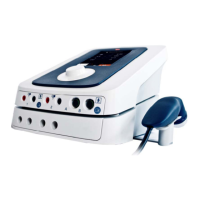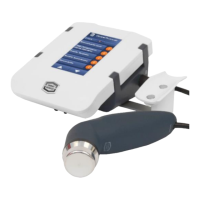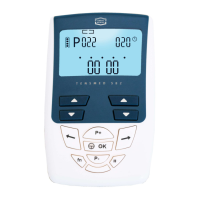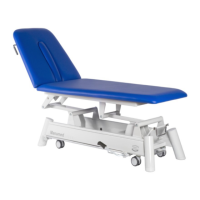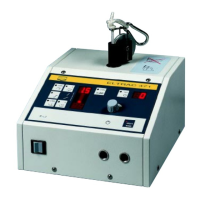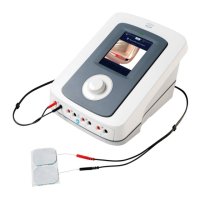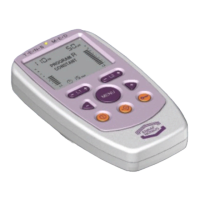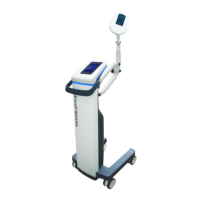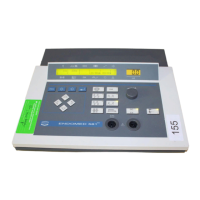26
7.1.3 Vacuum electrodes
There is a choice of large and small electrodes. The areas of the electrodes correspond to those of the 4
x 6cm and 6 x 8cm flexible rubber electrodes. The vacuum electrodes are sufficiently flexible to ensure
optimum contact with the skin, but rigid enough to prevent any changes in the contour of the part being
treated, allowing full advantage to be taken of the massage effect of the pulsed vacuum.
Keep the sponge pads well moistened during treatment.
After use clean the sponge pads as described in the User Maintenance instructions.
7.1.4 Self-adhesive electrodes
Self-adhesive electrodes have higher series impedance than flexible rubber electrodes. This can cause
the stimulator to terminate treatment at higher current amplitudes. When this occurs it is recommended to
continue the treatment with flexible rubber electrodes, combined with properly moistened sponge pads.
Self-adhesive electrodes are not recommended for use with currents that contain a DC component.
CAUTION: Do not use electrodes on open wounds.
7.1.5 Electrolytic effects
Electrolysis occurs under the electrodes when current types with a DC component are applied. Because
the largest concentration of electrolytic by-products caused by ion migration occur under the electrodes,
we recommend the use of the supplied sponges to keep the effects to a minimum. Make sure that the
sponges are kept well moistened and place the thick side of the sponge between the flexible rubber
electrode and the patient.
7.1.6 Current density
In the particular standard for Electrical Nerve and Muscle Stimulators, IEC 60601-2-10, it is
recommended not to exceed a current density of 2 mA r.m.s. / cm², otherwise skin irritations or burns can
occur. For current types that contain a DC component we recommend not to exceed a current density of
0.2 mA / cm².
To find the maximum recommended current amplitude in mA for the Interferential, Premodulated and
Russian Stimulation current waveforms, multiply the electrode surface in cm² by two. For all other current
waveforms the stimulator output current can never exceed 50 mA r.m.s. This implies that with an
electrode surface of 25 cm² the current density can never exceed 2 mA r.m.s. / cm². As a rule of thumb
for smaller electrodes, such as the 3.2mm self adhesives, the maximum current setting available on the
stimulator for a given current waveform should proportionally be reduced.
For a precise calculation of the r.m.s. value of a pulsed current waveform the following formula can be used:
I
RMS
= I
peak
√ ( Phase duration [µs] * pulse frequency [Hz] * 10
6
)
For symmetrical TENS currents, the Phase duration should be multiplied by 2. The value of the peak current I
peak
can be taken from the current display.
Electrodes should be placed with care, ensuring good electrical contact over the entire electrode surface.
7.1.7 Connection and disconnection reactions
Constant Current (CC) output characteristics may cause unpleasant connection and disconnection
reactions if the electrodes are not securely placed or lose contact with the skin. Make sure the current
amplitude is set to 0 mA when you apply or remove the electrodes. Use the Constant Voltage (CV) output
mode with dynamic electrode applications.
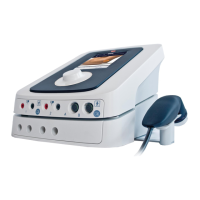
